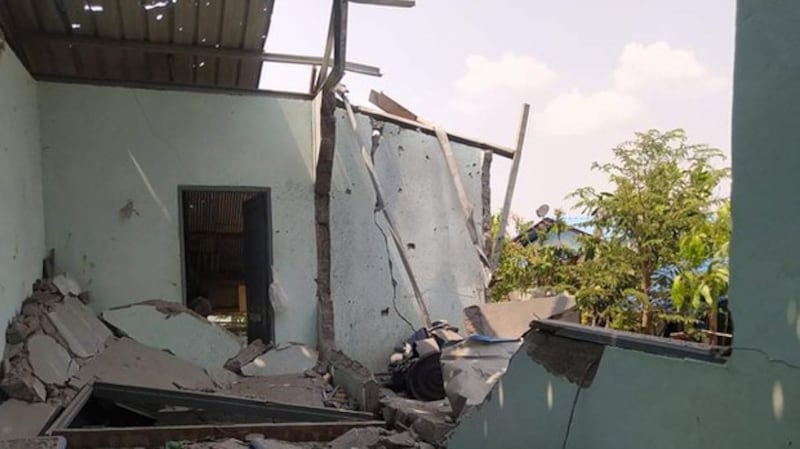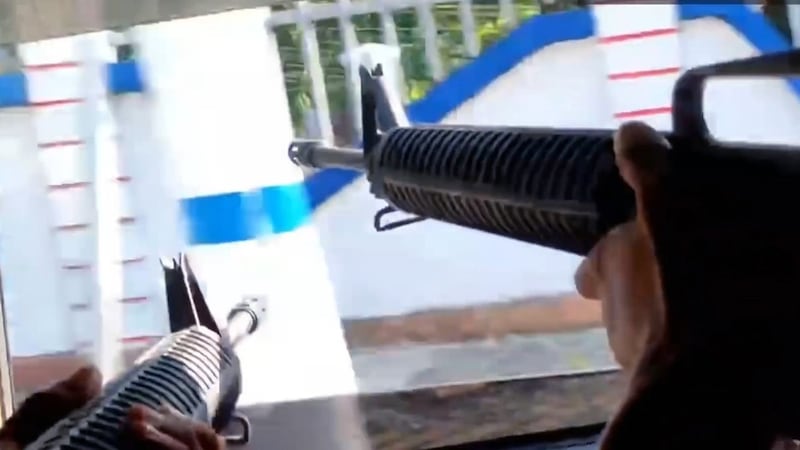Heavy fighting between junta troops and a joint force of ethnic fighters and prodemocracy paramilitaries in Myanmar’s Kayin state resulted in the largest number of casualties the military has suffered in clashes since it seized power last year, according to sources.
Karen National Liberation Army (KNLA) and anti-junta People’s Defense Force (PDF) fighters squared off with the military on Sunday after some 45 soldiers from the 207th Battalion, led by Maj. Thet Naing Oo of the 44th Division, approached the town of Lay Kay Kaw near the border with Thailand at around 2 a.m. on Sunday.
The KNLA’s Cobra Column reported that the junta forces began the attack at 5 a.m. with 40 mm guns, supported by heavy artillery fire from Swei Daw Hill and nearby Let Khat Taung township, as well as airstrikes. It said that by the time the fighting was done at around 11 p.m. on Sunday, the military had retreated, leaving 12 soldiers dead.
Padoh Saw Tawney, the foreign affairs officer of the Karen National Union (KNU), told RFA’s Myanmar Service that the military suffered its worst casualties since its Feb. 1, 2021, coup.
“There weren’t many of them, only about 40 or 50. We could say we wiped out the entire military column,” he said.
“They lost their commanding officer. One officer with three stars, the rank of a company commander, surrendered. We also seized a total of nine firearms and a lot of ammunition. And we lost two soldiers from our side.”
Padoh Saw Tawney said that the commanding officer, Maj. Thet Naing Oo, was killed in the fighting and that the company commander, Capt. Tin Lin Naing, “will be dealt with in accordance with the KNU’s code of conduct for prisoners of war.”
RFA was not able to independently confirm the number of casualties in the fighting.
Hpa-Tarah, the mayor of Lay Kay Kaw, said two military jets dropped “at least 16 bombs” in a bid to take control of the town.
“The fighting began at about 5 a.m. and ended at about 11 p.m., and then jet fighters flew in and bombed the area about 15 times between 11 p.m. and 2 p.m. [on Monday]. Two jets at a time — it was frightful,” he said.
“Their artillery units from the hills also shelled us. About 50 or 60 rounds. The shelling finally stopped at about 5 p.m. [on Monday].”
Residents of five villages in the area fled their homes because of the airstrikes on Sunday night, he said.
The airstrikes damaged about 30 houses and a school in Lay Kay Kaw, and burned down five houses, according to residents.
KNLA Cobra Column spokesman Myo Thura Ko Ko told RFA that the military might have used “chemical bombs” in the airstrikes.
“After the bombing raids, there was a strange smell,” he said. “Some of our comrades said it was kind of a sweet smell and some yellow dust was seen floating in the air. Some of them suffered from spells of dizziness.”
Attempts by RFA to contact junta Deputy Information Minister Zaw Min Tun for comment on the fighting went unanswered Monday.

Refugees face food shortage
An aid worker, who spoke on condition of anonymity, told RFA that thousands of residents have been sheltering on Myanmar’s side of the border since Dec. 15, when fighting first broke out between the military and anti-junta forces in the region.
“There aren’t many refugees from Lay Kay Kaw on the Thai side,” he said.
“There are about seven [refugee] camps on this side of the border. According to the latest findings, there are more than 12,000 in seven groups. Along the banks of the Moei River [which separates Myanmar and Thailand], from Phlu Lay village to Kyauk Khat village. All spread out.”
Myet Hman, a refugee on the banks of the Moei River, said there were more than 900 people from 600 households in his camp, adding that there is a severe food shortage.
“The problem is that we need food badly. Currently, roads are closed on the Thai side and aid workers do not dare to come to us from the Myanmar side. Donors cannot come to us because of several checkpoints,” he said.
“We are in dire need of food. We can only provide about a dozen milk-cans of rice to each family this month.”
He said the ongoing fighting makes it difficult to estimate when residents will be able to return to their homes.
KNU officials have reported daily clashes in areas under their administration, including the townships of Kawkareik and Kya Inn Seik Kyi, and say they are likely to intensify.

Yangon resistance
Meanwhile, various armed resistance groups told RFA on Monday that they had launched a dozen attacks on military-held areas of Myanmar’s commercial capital Yangon over the past three days.
A fighter with the Free Tiger Rangers said that a bomb exploded at a pro-junta garment factory in Yangon’s Hlaing Tharyar township at 7:30 p.m. on Sunday, damaging vehicles.
“The junta wants to show that there is peace and things are normal in Myanmar. The revolutionary forces cannot let that happen,” said the fighter, who declined to be named.
“The current situation is that we had a military coup, and we will fight the regime in whatever way we can.”
Separately, a video posted on social media Monday purports to show a group of anti-junta fighters in a car open fire on a military and police outpost on Yangon’s Inya Road on Sunday evening, killing a police officer.
Other anti-junta attacks in the Yangon region over the past three days included the killing of Maj. Kaday Phyo Aung, the Lanmadaw Township’s administration officer, by unknown gunmen, as well as the killing of two plainclothes soldiers nearby in a separate attack, although RFA was unable to confirm the information.
Junta spokesman Zaw Min Tun was not available for comment on the attacks.
According to reports by media aligned with the shadow National Unity Government, the NUG’s Yangon Region Military Command launched an operation to attack junta targets in the city beginning on April 8.
A resistance group known as the United Alliances announced a similar offensive a day earlier.
Anti-junta forces recently announced that they plan to launch attacks on the military during the Thingyan water festival, which begins on April 13 and culminates in the Burmese New Year three days later. They have warned members of the public to stay away from the traditional Thingyan pandals set up for performances and water-spraying stations during the festivities.
Since Feb. 1, 2021, authorities have killed 1,741 civilians and arrested more than 10,100, mostly during peaceful anti-junta protests, according to Thailand’s Assistance Association for Political Prisoners.
Translated by Khin Maung Nyane. Written in English by Joshua Lipes.
